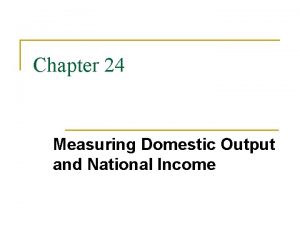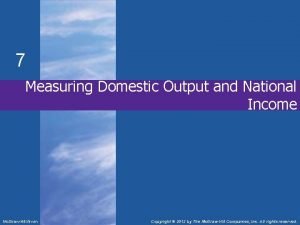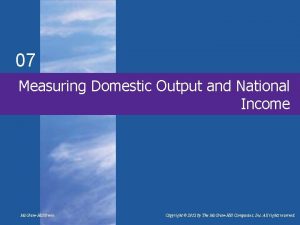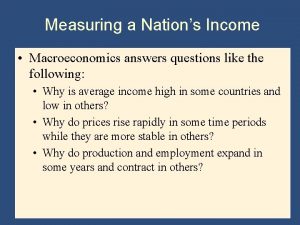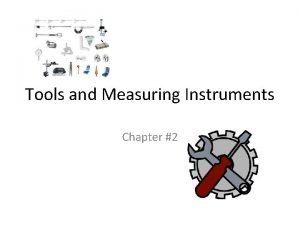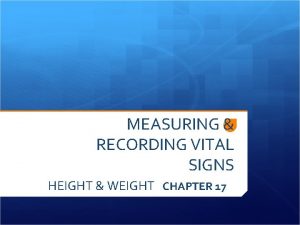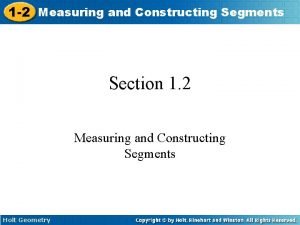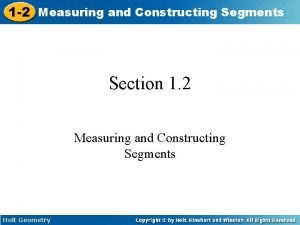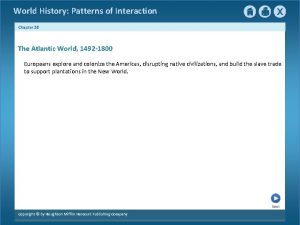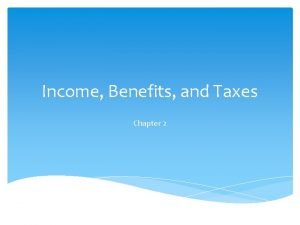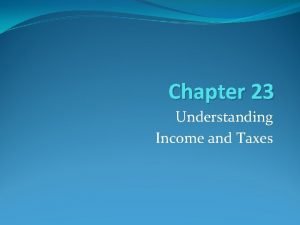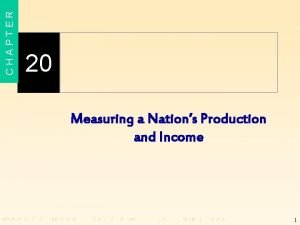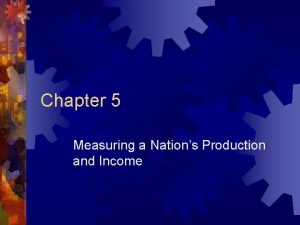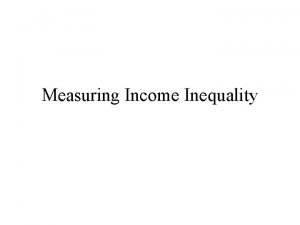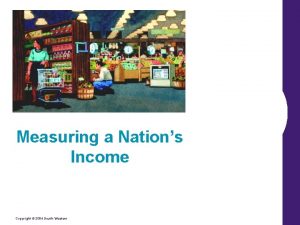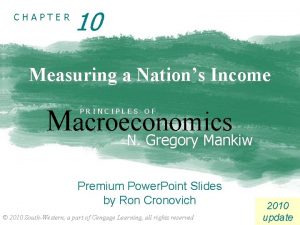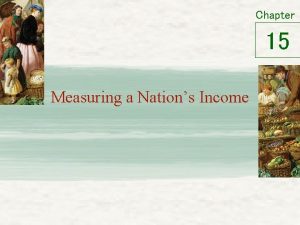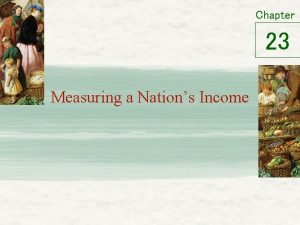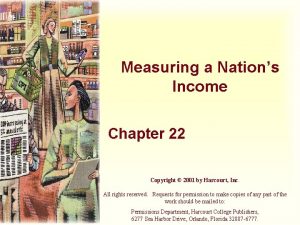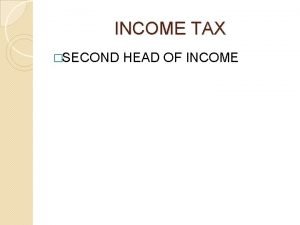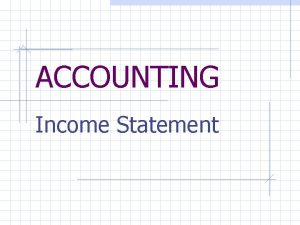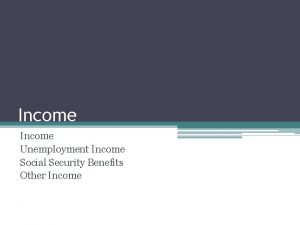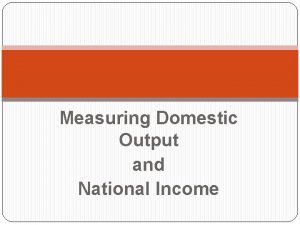CHAPTER 5 Measuring a Nations Production and Income































- Slides: 31

CHAPTER 5 Measuring a Nation’s Production and Income Copyright © 2012 Pearson Prentice Hall. All rights reserved. 5 -1

Measuring a Nation’s Production and Income CHAPTER 5 During the deep economic downturn in 2009 and 2010, economists, business writers, and politicians anxiously awaited the news from the government about the latest economic developments. PREPARED BY Copyright © 2012 Pearson Prentice Hall. All rights reserved. Brock Williams

CHAPTER 5 Measuring a Nation’s Production and Income APPLYING THE CONCEPTS 1 How can we use economic analysis to compare the size of a major corporation to the size of a country? Using Value Added to Measure the True Size of Wal-Mart 2 How severe was the most recent recession for the United States? Comparing the Severity of Recessions 3 Do increases in gross domestic product necessarily translate into improvements in the welfare of citizens? The Links Between Self-Reported Happiness and GDP Copyright © 2012 Pearson Prentice Hall. All rights reserved. 5 -3

CHAPTER 5 Measuring a Nation’s Production and Income MEASURING A NATION’S PRODUCTION AND INCOME ● macroeconomics The study of the nation’s economy as a whole; focuses on the issues of inflation, unemployment, and economic growth. ● inflation Sustained increases in the average prices of all goods and services. Copyright © 2012 Pearson Prentice Hall. All rights reserved. 5 -4

CHAPTER 5 Measuring a Nation’s Production and Income 5. 1 THE “FLIP” SIDES OF MACROECONOMIC ACTIVITY: PRODUCTION AND INCOME The Circular Flow of Production and Income FIGURE 5. 1 The Circular Flow of Production and Income The circular flow shows how the production of goods and services generates income for households and how households purchase goods and services produced by firms. Copyright © 2012 Pearson Prentice Hall. All rights reserved. 5 -5

CHAPTER 5 Measuring a Nation’s Production and Income 5. 2 THE PRODUCTION APPROACH: MEASURING A NATION’S MACROECONOMIC ACTIVITY USING GROSS DOMESTIC PRODUCT ● gross domestic product (GDP) The total market value of final goods and services produced within an economy in a given year. ● intermediate goods Goods used in the production process that are not final goods and services. Copyright © 2012 Pearson Prentice Hall. All rights reserved. 5 -6

CHAPTER 5 Measuring a Nation’s Production and Income 5. 2 THE PRODUCTION APPROACH: MEASURING A NATION’S MACROECONOMIC ACTIVITY USING GROSS DOMESTIC PRODUCT (cont’d) REAL-NOMINAL PRINCIPLE What matters to people is the real value of money or income—its purchasing power—not the face value of money or income. ● real GDP A measure of GDP that controls for changes in prices. ● nominal GDP The value of GDP in current dollars. ● economic growth Sustained increases in the real GDP of an economy over a long period of time. Copyright © 2012 Pearson Prentice Hall. All rights reserved. 5 -7

CHAPTER 5 Measuring a Nation’s Production and Income 5. 2 THE PRODUCTION APPROACH: MEASURING A NATION’S MACROECONOMIC ACTIVITY USING GROSS DOMESTIC PRODUCT (cont’d) FIGURE 5. 2 U. S. Real GDP, 1930– 2007 During the Great Depression in the 1930 s, GDP initially fell and then was relatively flat. The economy was not growing much. However, the economy began growing rapidly in the 1940 s during Word War II and has grown substantially since then. Copyright © 2012 Pearson Prentice Hall. All rights reserved. 5 -8

CHAPTER 5 Measuring a Nation’s Production and Income 5. 2 THE PRODUCTION APPROACH: MEASURING A NATION’S MACROECONOMIC ACTIVITY USING GROSS DOMESTIC PRODUCT (cont’d) The Components of GDP Economists divide GDP into four broad categories, each corresponding to different types of purchases represented in GDP: 1 2 3 4 Consumption expenditures: purchases by consumers Private investment expenditures: purchases by firms Government purchases: purchases by federal, state, and local governments Net exports: net purchases by the foreign sector (domestic exports minus domestic imports) Copyright © 2012 Pearson Prentice Hall. All rights reserved. 5 -9

CHAPTER 5 Measuring a Nation’s Production and Income 5. 2 THE PRODUCTION APPROACH: MEASURING A NATION’S MACROECONOMIC ACTIVITY USING GROSS DOMESTIC PRODUCT (cont’d) The Components of GDP CONSUMPTION EXPENDITURES ● consumption expenditures Purchases of newly produced goods and services by households. PRIVATE INVESTMENT EXPENDITURES ● private investment expenditures Purchases of newly produced goods and services by firms. Copyright © 2012 Pearson Prentice Hall. All rights reserved. 5 -10

CHAPTER 5 Measuring a Nation’s Production and Income 5. 2 THE PRODUCTION APPROACH: MEASURING A NATION’S MACROECONOMIC ACTIVITY USING GROSS DOMESTIC PRODUCT (cont’d) The Components of GDP PRIVATE INVESTMENT EXPENDITURES Private investment expenditures in GDP consist of three components: 1 2 3 First, there is spending on new plants and equipment during the year. Second, newly produced housing is included in investment spending. Finally, if firms add to their stock of inventories, the increase in inventories during the current year is included in GDP. Copyright © 2012 Pearson Prentice Hall. All rights reserved. 5 -11

CHAPTER 5 Measuring a Nation’s Production and Income 5. 2 THE PRODUCTION APPROACH: MEASURING A NATION’S MACROECONOMIC ACTIVITY USING GROSS DOMESTIC PRODUCT (cont’d) The Components of GDP PRIVATE INVESTMENT EXPENDITURES ● gross investment Total new investment expenditures. ● depreciation Reduction in the value of capital goods over a one-year period due to physical wear and tear and also to obsolescence; also called capital consumption allowance. ● net investment Gross investment minus depreciation. Copyright © 2012 Pearson Prentice Hall. All rights reserved. 5 -12

CHAPTER 5 Measuring a Nation’s Production and Income 5. 2 THE PRODUCTION APPROACH: MEASURING A NATION’S MACROECONOMIC ACTIVITY USING GROSS DOMESTIC PRODUCT (cont’d) The Components of GDP GOVERNMENT PURCHASES ● government purchases Purchases of newly produced goods and services by local, state, and federal governments. ● transfer payments Payments from governments to individuals that do not correspond to the production of goods and services. Not included in GDP. Copyright © 2012 Pearson Prentice Hall. All rights reserved. 5 -13

CHAPTER 5 Measuring a Nation’s Production and Income 5. 2 THE PRODUCTION APPROACH: MEASURING A NATION’S MACROECONOMIC ACTIVITY USING GROSS DOMESTIC PRODUCT (cont’d) The Components of GDP NET EXPORTS ● import A good or service produced in a foreign country and purchased by residents of the home country (for example, the United States). ● export A good or service produced in the home country (for example, the United States) and sold in another country. ● net exports Exports minus imports. Copyright © 2012 Pearson Prentice Hall. All rights reserved. 5 -14

CHAPTER 5 Measuring a Nation’s Production and Income 5. 2 THE PRODUCTION APPROACH: MEASURING A NATION’S MACROECONOMIC ACTIVITY USING GROSS DOMESTIC PRODUCT (cont’d) The Components of GDP NET EXPORTS ● trade deficit The excess of imports over exports. ● trade surplus The excess of exports over imports. Copyright © 2012 Pearson Prentice Hall. All rights reserved. 5 -15

CHAPTER 5 Measuring a Nation’s Production and Income 5. 2 THE PRODUCTION APPROACH: MEASURING A NATION’S MACROECONOMIC ACTIVITY USING GROSS DOMESTIC PRODUCT (cont’d) The Components of GDP NET EXPORTS FIGURE 5. 3 U. S. Trade Balance as a Share of GDP, 1960– 2009 In the early 1980 s, the United States ran a trade surplus (when the line on the graph is above zero, this indicates a surplus). However, in other years the United States has run a trade deficit. In 2004 - 2006, the trade deficit exceeded 5 percent of GDP. Recently, it is near 3 percent of GDP Copyright © 2012 Pearson Prentice Hall. All rights reserved. 5 -16

CHAPTER 5 Measuring a Nation’s Production and Income 5. 2 THE PRODUCTION APPROACH: MEASURING A NATION’S MACROECONOMIC ACTIVITY USING GROSS DOMESTIC PRODUCT (cont’d) Putting It All Together: The GDP Equation Y = C + I + G + NX where Y = GDP C = Consumption I = Investment G = Government purchases NX = net exports In other words, GDP = consumption + investment + government purchases + net exports Copyright © 2012 Pearson Prentice Hall. All rights reserved. 5 -17

CHAPTER 5 Measuring a Nation’s Production and Income 5. 3 THE INCOME APPROACH: MEASURING A NATION’S MACROECONOMIC ACTIVITY USING NATIONAL INCOME Measuring National Income ● national income The total income earned by a nation’s residents both domestically and abroad in the production of goods and services. ● gross national product GDP plus net income earned abroad. Copyright © 2012 Pearson Prentice Hall. All rights reserved. 5 -18

CHAPTER 5 Measuring a Nation’s Production and Income 5. 3 THE INCOME APPROACH: MEASURING A NATION’S MACROECONOMIC ACTIVITY USING NATIONAL INCOME (cont’d) Measuring National Income ● personal income Income, including transfer payments, received by households. ● personal disposable income Personal income that households retain after paying income taxes. Copyright © 2012 Pearson Prentice Hall. All rights reserved. 5 -19

CHAPTER 5 Measuring a Nation’s Production and Income 5. 3 THE INCOME APPROACH: MEASURING A NATION’S MACROECONOMIC ACTIVITY USING NATIONAL INCOME (cont’d) Measuring National Income through Value Added ● value added The sum of all the income—wages, interest, profits, and rent—generated by an organization. For a firm, we can measure value added by the dollar value of the firm’s sales minus the dollar value of the goods and services purchased from other firms. Copyright © 2012 Pearson Prentice Hall. All rights reserved. 5 -20

CHAPTER 5 Measuring a Nation’s Production and Income APPLICATION 1 USING VALUE ADDED TO MEASURE THE TRUE SIZE OF WAL-MART APPLYING THE CONCEPTS #1: How can we use economic analysis to compare the size of a major corporation to the size of a country? During 2008, Wal-Mart’s sales were approximately $374 billion, nearly 2. 6 percent of U. S. GDP. Some social commentators might want to measure the impact of Wal-Mart just through its sales. But to produce those sales, Wal-Mart had to buy goods from many other companies. • Based on Wal-Mart’s annual reports, its cost of sales was $286 billion, leaving approximately $88 billion in value added. • If we used Wal-Mart’s sales to compare it to a country, it would have a GDP similar to that of Belgium, which is ranked 28 th in the world. • However, using the more appropriate measure of value added, Wal. Mart’s size is closer to Bulgaria, ranked 56 th in the world. Copyright © 2012 Pearson Prentice Hall. All rights reserved. 5 -21

CHAPTER 5 Measuring a Nation’s Production and Income 5. 3 THE INCOME APPROACH: MEASURING A NATION’S MACROECONOMIC ACTIVITY USING NATIONAL INCOME (cont’d) An Expanded Circular Flow FIGURE 5. 4 The Circular Flow with Government and the Foreign Sector The new linkages (in blue) demonstrate the roles that the government and the foreign sector (imports and exports) play in the circular flow. Copyright © 2012 Pearson Prentice Hall. All rights reserved. 5 -22

CHAPTER 5 Measuring a Nation’s Production and Income 5. 4 A CLOSER EXAMINATION OF NOMINAL AND REAL GDP Measuring Real versus Nominal GDP FIGURE 5. 5 U. S. Nominal and Real GDP, 1950– 2009 This figure plots both real and nominal GDP for the United States in billions of dollars. Real GDP is measured in 2000 dollars. Copyright © 2012 Pearson Prentice Hall. All rights reserved. 5 -23

CHAPTER 5 Measuring a Nation’s Production and Income 5. 4 A CLOSER EXAMINATION OF NOMINAL AND REAL GDP (cont’d) How to Use the GDP Deflator ● GDP deflator An index that measures how the prices of goods and services included in GDP change over time. ● chain-weighted index A method for calculating changes in prices that uses an average of base years from neighboring years. Copyright © 2012 Pearson Prentice Hall. All rights reserved. 5 -24

CHAPTER 5 Measuring a Nation’s Production and Income 5. 5 FLUCTUATIONS IN GDP FIGURE 5. 6 The 1990 Recessions can be illustrated by peaks, troughs, and an expansion phase. The date at which the recession starts and output begins to fall is called the peak. The date at which the recession ends and output begins to rise is called the trough. The expansion phase begins after the trough. Copyright © 2012 Pearson Prentice Hall. All rights reserved. 5 -25

CHAPTER 5 Measuring a Nation’s Production and Income 5. 5 FLUCTUATIONS IN GDP (cont’d) ● recession Commonly defined as six consecutive months of declining real GDP. ● peak The date at which a recession starts. ● trough The date at which output stops falling in a recession. ● expansion The period after a trough in the business cycle during which the economy recovers. Copyright © 2012 Pearson Prentice Hall. All rights reserved. 5 -26

CHAPTER 5 Measuring a Nation’s Production and Income 5. 5 FLUCTUATIONS IN GDP (cont’d) ● depression The common name for a severe recession. Copyright © 2012 Pearson Prentice Hall. All rights reserved. 5 -27

CHAPTER 5 Measuring a Nation’s Production and Income APPLICATION 2 COMPARING THE SEVERITY OF RECESSIONS APPLYING THE CONCEPTS #2: How severe was the most recent recession for the United States? Was the most recent recession the most severe since the Great Depression? ▪ The recession starting in December 2007 appears to have had a fall in output of 4. 1% ▪ The recession starting in November 1973 had a fall in output of 4. 1% ▪ The 1973 recession last 16 months while the 2007 recession has lasted 18 months. ▪ Unemployment in 1973 increased from 4. 9% to 8. 5% while the 2007 recession saw unemployment increase from 4. 6% to 10%. ▪ As more information becomes available, analysis will continue including looking at the incomes of those that lost their jobs. Copyright © 2012 Pearson Prentice Hall. All rights reserved. 5 -28

CHAPTER 5 Measuring a Nation’s Production and Income 5. 6 GDP AS A MEASURE OF WELFARE Shortcomings of GDP as a Measure of Welfare HOUSEWORK AND CHILDCARE LEISURE UNDERGROUND ECONOMY POLLUTION Copyright © 2012 Pearson Prentice Hall. All rights reserved. 5 -29

CHAPTER 5 Measuring a Nation’s Production and Income APPLICATION 3 THE LINKS BETWEEN SELF-REPORTED HAPPINESS AND GDP APPLYING THE CONCEPTS #3: Do increases in gross domestic product necessarily translate into improvements in the welfare of citizens? Both the US and the UK have experienced very large increases in per capita income over the last 30 years But, reported levels of happiness have declined slightly in the United States and remained relatively flat in the United Kingdom. Could it be the increased stress of everyday life has taken its toll on our happiness despite the increase in income? Trends in the relative happiness of different groups in our society: • While whites report higher levels of happiness than African Americans, the gap has decreased over the last 30 years, as the happiness of African Americans has risen faster than that of whites. • Men’s happiness has risen relative to that of women over the last 30 years. • Controlling for income, education, and other personal factors, they found that in the United States, happiness among men and women reaches a minimum at the ages of 49 and 45 respectively. Copyright © 2012 Pearson Prentice Hall. All rights reserved. 5 -30

CHAPTER 5 Measuring a Nation’s Production and Income chain-weighted index consumption expenditures depreciation depression economic growth expansion export GDP deflator government purchases gross domestic product (GDP) gross investment Copyright © 2012 Pearson Prentice Hall. All rights reserved. KEY TERMS gross national product (GNP) personal disposable income import private investment expenditures inflation real GDP intermediate goods recession macroeconomics trade deficit national income trade surplus net exports transfer payments net investment trough nominal GDP value added peak personal income 5 -31
 Proses post production
Proses post production Measuring domestic output and national income
Measuring domestic output and national income Measuring domestic output and national income
Measuring domestic output and national income Measuring domestic output and national income
Measuring domestic output and national income Measuring domestic output and national income
Measuring domestic output and national income Measuring a nation's income
Measuring a nation's income Real gdp per capita formula
Real gdp per capita formula Deferred tax asset and liability
Deferred tax asset and liability Income statement multi step
Income statement multi step Loss contingency journal entry
Loss contingency journal entry Graphing tpr
Graphing tpr Chapter 2 tools and measuring instruments
Chapter 2 tools and measuring instruments Chapter 16.5 graphing tpr answer key
Chapter 16.5 graphing tpr answer key Chapter 16:7 measuring and recording blood pressure
Chapter 16:7 measuring and recording blood pressure Chapter 15:2 measuring and recording temperature
Chapter 15:2 measuring and recording temperature Chapter 21:1 measuring/recording height and weight
Chapter 21:1 measuring/recording height and weight Tpr sheet plotting
Tpr sheet plotting 1-2 measuring and constructing segments
1-2 measuring and constructing segments 1-2 measuring and constructing segments
1-2 measuring and constructing segments The colonies become new nations
The colonies become new nations European nations settle north america chapter 20 section 2
European nations settle north america chapter 20 section 2 Chapter 18 the colonies become new nations
Chapter 18 the colonies become new nations Chapter 15 section 4 - aggressors invade nations answer key
Chapter 15 section 4 - aggressors invade nations answer key Chapter 31 section 4 aggressors invade nations
Chapter 31 section 4 aggressors invade nations Aggressors invade nations
Aggressors invade nations Chapter 22 section 1 the nations sick economy
Chapter 22 section 1 the nations sick economy European nations settle north america chapter 4 section 2
European nations settle north america chapter 4 section 2 Chapter 20 section 1 world history
Chapter 20 section 1 world history Chapter 20 section 2 european nations settle north america
Chapter 20 section 2 european nations settle north america European nations settle north america
European nations settle north america Chapter 2 income benefits and taxes
Chapter 2 income benefits and taxes Chapter 23 understanding income and taxes
Chapter 23 understanding income and taxes

